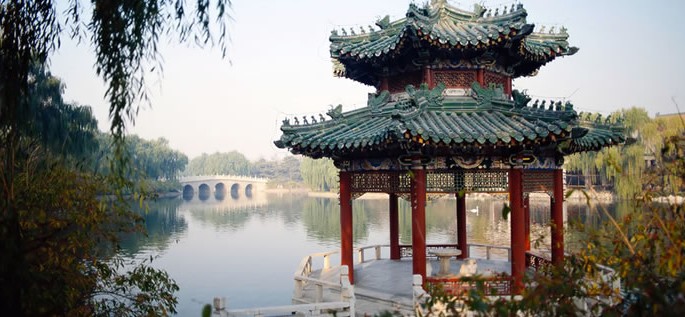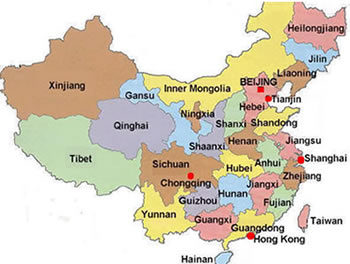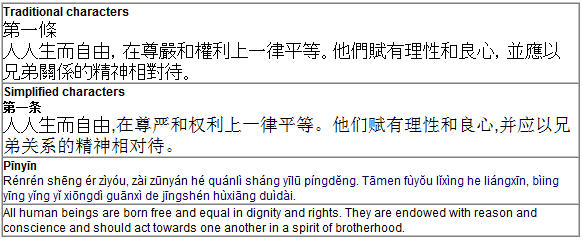
Mandarin (Chinese)
Mandarin (pŭtōnghuà, guóyŭ, huáyŭ) is the most widely spoken of all Chinese dialects spoken as a first language in a vast area of northern and southwestern mainland China. There is also a huge diaspora of Mandarin speakers in Brunei, Cambodia, Hong Kong, Indonesia, Laos, Malaysia, Mauritius, Mongolia, Philippines, Russia, Singapore, Taiwan, Thailand, United Kingdom, USA, and Viet Nam. With close to 850 million speakers, Mandarin Chinese is by far the world’s largest language.
→Click on the MLA Interactive Language Map to find out where Chinese (all dialects) is spoken in the United States.
Status
- Mainland China and Taiwan
Standard Mandarin is the official language of mainland China and of Taiwan where it serves as a lingua franca for speakers of mutually unintelligible dialects. Standard Mandarin is used in all spheres of informal and formal communication. It serves as the medium of instruction at all educational levels as well as in all media. The use of Standard Mandarin has facilitated communication among people who speak a variety of mutually unintelligible dialects and languages. As a result, Standard Mandarin is now spoken with varying degrees of fluency and with differences in pronunciation by most people in mainland China and in Taiwan. - Singapore
Standard Mandarin is one of the four official languages of Singapore along with English, Tamil and Malay. Although English is the primary medium of instruction in elementary schools, Mandarin, Tamil, and Malay are taught in schools of the respective language communities. Schools in the Chinese community receive extra funding to teach Mandarin and to use it as a medium of instruction since the majority of ethnic Chinese in Singapore are speakers of Min Nan Chinese and have to learn Mandarin as a second dialect.
Dialects
Mandarin is the major dialect of China both in terms of number of speakers (about 70% of the total population) and political importance.The term Mandarin is an English translation of guān-huà ‘official language’, i.e., the dialect spoken in Beijing. The Beijing dialect has been the standard for the official language of China for many centuries. Because of geographical and political considerations, the language came to be known by different names: in the People’s Republic of China it is called pŭtōnghuà ‘common speech’, in Taiwan it is called guóyŭ ‘national language’, and in Singapore and Malaysia it is called huáyŭ ‘Chinese language.’ Although pŭtōnghuà, guóyŭ and huáyŭ are all technically based on the Beijing dialect, they differ from the dialect spoken in Beijing. They also differ from each other mostly in pronunciation and vocabulary.
Mandarin spoken in mainland China is usually divided into four main regional varieties that, for the most part, are mutually intelligible (Ethnologue).
- Northern Mandarin (Huabei Guanhua) includes the Beijing dialect.
- Eastern Mandarin (Jinghuai Guanhua)
- Northwestern Mandarin (Xibei Guanhua)
- Southwestern Mandarin (Xinan Guanhua)
Structure
Sound system
The pronunciation of Mandarin varies widely along geographical and social lines. People use elements of their native dialect when they speak it. By contrast, television and radio announcers usually attempt to emulate an idealized version of Standard Mandarin. Below is a short description of the phonology of Standard Mandarin usually heard on television and on the radio.
Syllable structure
The syllable structure in Mandarin consists of an optional initial consonant + vowel (accompanied by tone) + optional final consonant (n or ng).
Vowels
Mandarin Chinese has 7 vowel phonemes, i.e., sounds that make a difference in word meaning. The number of vowel phonemes in Mandarin is not universally agreed upon.
| Close |
i
|
y
|
u
|
|
| Mid |
e
|
ə
|
o
|
|
| Open |
a
|
|||
- /y/ is similar to second vowel in statue
- /ə/ = a in about
Consonants
Mandarin has 22 consonant phonemes which are presented in the table below.
|
Alveolopalatal
|
|||||||
|---|---|---|---|---|---|---|---|
| Stops | unaspirated |
p
|
t
|
k
|
|||
| aspirated |
pʰ
|
tʰ
|
kʰ
|
||||
| Fricatives |
f
|
s
|
ʂ
|
ɕ | |||
| Affricates | unaspirated |
ts
|
tʂ
|
tɕ |
|||
| aspirated |
tsʰ
|
tʂʰ
|
tɕʰ
|
||||
| Nasals |
m
|
n
|
ŋ
|
||||
| Lateral |
l
|
||||||
| Approximants |
w
|
ɻ
|
- Mandarin Chinese does not have a contrast between voiceless and voiced stops and affricates such as between /p – b/,/ or /ts – dz/, etc. Instead, there is a contrast between voiceless unaspirated and voiceless aspirated consonants, e.g., /p – pʰ/, ts – tsʰ/, even though In Pīnyīn, voiceless unaspirated /p/, /t/, /k/ are written as b, d, g. Aspirated consonants are produced with a strong puff of air. In the table below they are marked with a raised ‘h’.
- Only the nasal consonants /n/ and//ŋ/ can appear at the end of syllables.
- Retroflex consonants /ʂ/, /tʂ/, /tʂʰ/ are produced with the tongue curled, so that its underside comes in contact with the roof of the mouth.
- /ɕ/ similar to h in hue
- /tɕ/ is similar to ch in cheese
- /ŋ/ = ng in song
- /ɻ/ = r in red
Tones
Every syllable in Mandarin Chinese has a pitch that is an integral part of its pronunciation. Pitch distinguishes one syllable from another syllable that consists of the same consonants and vowels. The romanization system adopted by the government of the People’s Republic of China, called Pīnyīn, represents tones by diacritical marks over vowels. Thus, for Mandarin which has four tones, the syllable ma can be written in the following four ways that indicate tones. As you can see, tones make a difference in the meaning of these otherwise identical syllables.
| 1st tone | high-level | mā | ‘mother’ |
| 2nd tone | rising | má | ‘hemp’ |
| 3rd tone | falling-rising | mă | ‘horse’ |
| 4th tone | falling | mà | ‘scold’ |
Grammar
Mandarin, like all other Chinese languages, is predominantly an isolating, or analytic, language, meaning that for the most part, words have only one grammatical form. Grammatical functions are expressed through word order, particles, prepositions, and discourse, rather than by suffixes attached to nouns or verbs, such as in Indo-European languages. Because of the lack of inflections, Chinese grammar may appear quite simple compared to that of Indo-European languages.
Nouns
Mandarin nouns are not marked for number, gender or case. Below are some of the most frequent noun markers.
- Classifiers
Classifiers are noun markers that are attached to quantifiers and demonstratives. There is one general classifier –ge which occurs with most nouns, e.g., sān-ge chēzi ‘three [classifier] cars’. In general, a noun in Chinese can occur with only one classifier. There are dozens of classifiers, and one has to learn which classifier goes with which noun. As an example, the classifier for books is bĕn, e.g., yī-bĕn shū ‘one [classifier] book’. - Locative markers
Locative markers occur with prepositions and nouns to specify location, e.g., wŏ zài chuáng-shàn ‘I in bed on’. - Possessive (genitive) marker)
The possessive marker –de is used with personal pronouns, turning them into possessive pronouns, e.g., wŏ-de ‘I + possessive = my’.
Verbs
Mandarin verbs are not marked for person and number. The most important verb category is aspect. The perfective aspect is marked by the suffix –le, e.g., wŏ chī-le sān-wăn fàn ‘I eat [perfective marker] three [classifier] rice’.
Sentence markers
There is a set of particles that occur at the end of sentences. For instance, the particle ma placed at the end of a sentence changes statements into questions, e.g., tā chī-le ‘He/she ate’ and tā chī-le ma? ‘Has he eaten?’
Word order
Chinese is a topic-prominent language. This means that the topic of the sentence, defined as old or known information, precedes comment, i.e., new or added information. For example,
|
Topic (old or known information)
|
Comment (new or added information)
|
|
zhèi-bĕn shū
|
wŏ kàn-guo le
|
|
‘This book’
|
‘I have read’
|
Vocabulary
Mandarin shares most of its vocabulary with other Chinese dialects. Foreign words and concepts are adopted by creating new compound words that translate the concept behind them. For example, the word for computer is diànnao, ‘electric brain’, the word for telephone is diànhuà, literally ‘electric speech’. Transliteration of borrowed words does not work very well in Chinese because Chinese characters are not well-suited to represent foreign sounds, and because the pronunciation of characters differs from dialect to dialect.
Most Mandarin words are made up of one or two morphemes. Grammatical categories such as number, person, case, tense, and aspect are not expressed by inflections. The most common word building devices in Mandarin are described below.
- Compounding
Examples of nominal compounds are fàn-wăn ‘rice bowl,’ and hŭo-chē ‘fire + vehicle = train’. - Reduplication
Another frequently used word building device is reduplication, e.g., rén ‘person’ and rénrén ‘people’. - Prefixation
Prefixation is not very common, but a prefix can be added to a verb to form an adjective, e.g., the prefix kă– can be added to the verb xiào ‘laugh’ to form an adjective kă-xiào ‘laughable’. - Suffixation
There are few derivational suffixes. One example is jiā ‘-ist’, e.g., lishĭ-jiā ‘historian’. - Borrowing
Chinese tends not to borrow words from other languages. Instead, it uses native elements to create words for expressing new concepts, e.g.,dyàn-huà ‘electricity + speech = telephone’.
Below are some common words and phrases in Mandarin.
|
Pīnyīn
|
Traditional characters
|
|
|---|---|---|
| Hello |
nǐ hǎo |
|
| Good-bye |
zàijiàn
|
|
| Thank you |
xièxè
|
|
| Please |
qĭng
|
|
| Man |
rén
|
|
| Woman | nǚrén |
女人
|
Below are the numerals 0-10 in Mandarin.
|
0
|
1
|
2
|
3
|
4
|
5
|
6
|
7
|
8
|
9
|
10
|
|
|---|---|---|---|---|---|---|---|---|---|---|---|
| Pīnyīn |
líng
|
yī
|
èr
|
sān
|
sì
|
wŭ
|
liù
|
qī
|
bā
|
jiŭ
|
shí
|
| Characters |
0
|
|
|
|
|
|
|
|
|
|
|
Writing
The Chinese writing system is described in the Chinese branch page on this website.
Take a look at Article 1 of the Universal Declaration of Human Rights in traditional characters, simplified characters, and in Pīnyīn. Although Chinese has been traditionally written vertically and from right to left, the modern trend is to write it horizontally and from left to right, just as it was done below.
Did You Know?
English has borrowed many words from Mandarin Chinese. Among them are the following:
| Chow mein | American English, from Manarin chăo miàn ‘fried noodles’. |
| Feng shui | A system of spiritual influences in natural landscapes and a means for regulating them. From Mandarin fēng ‘wind’ + shŭi ‘water’. |
| Gung ho | Slang motto of Carlson’s Raiders, U.S. guerrilla unit operating in the Pacific during World War II. From gōng hé ‘work together, cooperate’. |
| Kowtow | Custom of touching the ground with the forehead to show respect or submission. From kētóu, literally kē ‘knock’ + tóu ‘head’. |
| Oolong | Dark variety of Chinese tea, from Mandarin wūlóng ‘back dragon’. |
| Shih-tzu | Small long-haired dog, from Mandarin zhīzigŏu, from zhī ‘lion’ + zi ‘son’ + gŏu ‘dog’. |
| Tai chi | ‘The supreme ultimate’ in Taoism and New Confucianism, from Mandarin tài ‘extreme’ + jí ‘limit’. The form of martial arts training in full is tàijíqúan, literally tài ‘extreme’ + jí ‘limit’ + qúan ‘fist’. |
| Tao | Religious system founded by Lao Tzu, from Mandarin tào ‘way, path, reason’ |
| Tea | From Amoy dialect of Chinese t’e. The Mandarin word is chá. The distribution of the different forms of the word reflect the spread of the beverage in Europe. The modern English word for tea, along with French the, Spanish te, German Tee, etc., derive via Dutch thee from the Amoy dialect. The Portuguese form cha, Russian chay, Arabic shay, all came from the Mandarin form chá. |
| Tofu | ‘Soy bean curd,’ from Japanese tofu, from Mandarin dòufu, from dòu ‘beans’ + fu ‘rotten’. |
Difficulty
 How difficult is it to learn Mandarin?
How difficult is it to learn Mandarin?Mandarin is considered to be a Category III language in terms of difficult for speakers of English.

